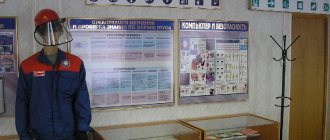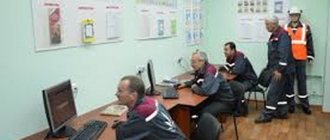Each employee, regardless of position, specialty and workplace on the basis of Ch. 34 of the Labor Code of the Russian Federation, the employer must create safe working conditions and provide information about possible risks, dangerous and harmful parameters associated with his work activities, as well as measures to minimize them. For this purpose, labor safety instructions are used - internal regulatory documents containing requirements for ensuring safety during the performance of official duties and work in production.
Are labor safety instructions required?
Instructions can be drawn up for a position, profession or type of work determined by the nature of the organization's activities. In 2020, there are 725 standard instructions in force. From January 1, 2021, some of them will lose force in accordance with Decree of the Government of the Russian Federation dated 08/04/2020 No. 1181 and orders of relevant ministries.
The lack of instructions is an administrative violation and provides for the imposition of a fine on the organization, individual entrepreneur or employee responsible for safety (Article 5.27.1 of the Code of Administrative Offenses of the Russian Federation). The amount of the fine for “ordinary” individuals and individual entrepreneurs is from 2,000 to 5,000 rubles, for organizations - from 50,000 to 80,000 rubles.
The employer's internal instructions on labor protection are formed on the basis of standard ones developed by government authorities (Article 216 of the Labor Code of the Russian Federation). There are industry-specific and inter-industry standard instructions .
The scope of application of the former is limited to a specific industry and narrow work specializations. Cross-industry ones are more universal. Coordination of industry-specific instructions and approval of inter-industry standard instructions is carried out by the Ministry of Labor of Russia.
Procedure for developing instructions
Different types of instructions for different industries.
The act for the employee is drawn up on the basis of Methodological Recommendations, which are regulated by decree of the Ministry of Labor, based on the type of work and profession of the person. The rules are drawn up based on the decree of the head.
Safety measures are drawn up based on interindustry or industry standard instructions on occupational safety (if it does not exist, then on the basis of the rules) of the norms described in the operational or repair documentation of the enterprise (machine manufacturers).
Also in the technological acts of the company, taking into account individual working conditions. All rules must be applicable to a particular profession or activity.
All instructions that are at the drafting stage must be studied by the employer and sent to all structures of the company. Next, the rules are created by the head of the department (section, structure), coordinated with labor protection and confirmed by the chief director.
The development of temporary acts is used to commission third-party or restored production.
They are used to maintain safety and secure operations in individual production. The temporary instruction is valid until the industry is put into operation.
Requirements for the content of labor protection instructions
Labor safety instructions, in accordance with methodological recommendations, approved. Resolution of the Ministry of Labor of the Russian Federation dated December 17, 2002 No. 80, contains sections:
- general labor protection requirements;
- labor protection requirements: before starting,
- while working,
- upon completion of work;
Below in the table you will see a short list of information required to be included in the instructions:
| Section name | Section Contents |
| General requirements |
|
| Requirements before starting work |
|
| Requirements while working |
|
| Completion requirements |
|
| Requirements in emergency situations |
|
Instructions for workers in blasting operations, as well as specialists engaged in servicing devices and installations (elevators, lifting mechanisms, pressure vessels, etc.) under the jurisdiction of Gosgortekhnadzor, are drawn up and approved according to its regulations.
What instructions should the company have?
Article 212 of the Labor Code of the Russian Federation states that the employee must be informed about all the risks, harmful and hazardous production factors at a particular workplace. The employee must know what protective measures he is required to use to eliminate health hazards.
Therefore, labor safety instructions must be developed at each workplace, depending on the tools, equipment, machines used by employees, as well as work conditions, for example, working at heights, working in electrical installations, working in confined spaces.
Each enterprise must have its own unique list of occupational safety instructions. Safety instructions are mandatory for all enterprises:
- when working on a PC and other office equipment.
- during operation, maintenance and repair of equipment
- during hot work
- when working at height
- when performing electric and gas welding work
As you can see, instructions are developed either by type of work or by profession. But there are also additional instructions, for example, when carrying out traveling work, when sending on a business trip, etc.
Validity period of labor safety instructions
It is recommended that internal instructions be reviewed and updated every 5 years. Sometimes this is done outside of the plan. Reasons for early renewal:
- changes in standard instructions and rules on labor protection;
- instructions from inspection authorities or a higher organization;
- replacement of equipment, change in work technology, etc.;
- updating personal protective equipment;
- emergency and emergency situations, the analysis of which indicated shortcomings in the instructions.
The procedure for agreeing and approving instructions
Who approves the instructions?
All instructions created must be negotiated with the trade union (or other authorized representative) if one is established. In the absence of such a department or representative, the document goes to the department of the heads of these departments. Representatives of the labor service participate in the process, and the final version is approved by the director of the organization.
In addition to the labor protection specialist, the act, if necessary, is coordinated with other parties (technologist, etc.).
When an act is approved, based on the conclusion of the representative body of employees, in the upper left corner, on the main sheet, the stated opinion is not taken into account (usually in the rules, the full scope of which should be kept by the occupational safety engineer and the person to whom the responsibilities of the engineer were assigned by the decrees of the manager , there is a separate document containing the conclusion of the representative body).
If the act was agreed upon with the representative body of this company, such approval is taken into account in the left corner of its front sheet.
The final version is signed by the head of the company (for example, employer - individual entrepreneur, etc.) or his deputy responsible for labor protection (based on the order).
Each approved instruction is assigned a separate name and designation (there may be numbers or letters that determine membership in a specific organizational structure).
Let's sum it up
- The employer is obliged to create safe working conditions for its employees and provide them with information about possible risks, dangerous and harmful factors, as well as ways to minimize them. For this purpose, enterprises are developing labor protection instructions.
- The absence of instructions on labor protection threatens the imposition of a fine on the violator: this could be the organization itself (or individual entrepreneur), as well as a specific individual.
- You will find a large selection of standard instructions in the legal reference service ConsultantPlus.
If you find an error, please select a piece of text and press Ctrl+Enter.
Fire safety
The mandatory availability of instructions on labor protection and fire safety is determined by Section XVIII of the rules approved by Government Decree No. 1479 of September 16, 2020. When developing the document, it is necessary to be guided by the requirements of federal laws No. 69-FZ of December 21, 1994 “On Fire Safety” and No. 123-FZ of July 22, 2008 “Technical Regulations on Fire Safety Requirements”, which contain basic formulations, terms and requirements, technical information character about fire safety standards. You can use standard instructions on labor protection for professions and types of work, for example, standard instructions on the safe conduct of work for boiler room personnel, RD 10-319-99 (approved by Resolution of Gosgortekhnadzor No. 49 of 08/19/1999).
ConsultantPlus experts examined how fire safety briefings are conducted. Use these instructions for free.
Responsible persons (the employer is the responsible person in any case) in case of violations are punished with a fine of up to 1,000,000 rubles and risk going to prison for up to 7 years. When hired, workers undergo initial training, during which they also study the safety instructions adopted at the enterprise and for certain types of work.
Why is it required?
According to current legislation, the list of current labor protection rules is not a mandatory document. At the same time, in Art. 212 of the Labor Code of the Russian Federation establishes that the employer is obliged to ensure the availability of a set of regulations on labor protection, taking into account the specifics of the enterprise’s activities.
It makes sense to maintain a list of occupational safety instructions for the following purposes:
- optimization of work on the development of occupational safety regulations;
- proper training of employees;
- creating a list of cases.
Training Procedure No. 1/29 states that instruction is carried out in accordance with the employee’s job responsibilities and the technological features of the equipment used. It turns out that occupational safety rules should be drawn up for the position or profession of almost every employee.
Why create a job description for an occupational safety specialist in 2021?
It is necessary to draw up a job description in order to describe in detail all the responsibilities of a labor protection specialist in the organization. This is done to:
1. Create a list of work that needs to be performed by a specialist. This document lists the functional responsibilities of a labor protection engineer, the strict implementation of which is going to be paid by the employer.
2. Designate the boundaries of the area of responsibility. A detailed job description for a labor safety specialist allows him to be freed from doing someone else’s work and gives him the opportunity to focus exclusively on his professional responsibilities.
3. Determine the requirements for a specialist. The instructions contain instructions on what an occupational safety engineer should know, what education and work experience to have, what equipment to work with, what production processes to know well, what reports to prepare, etc.
4. Coordinate the work of departments. The instructions list which departments, in what situations and on what issues the occupational safety engineer collaborates. This will help him to easily access the information necessary for his work, include representatives of various departments in the commissions, and take part in the work of the commissions and events. Lists of persons who report to the occupational safety engineer, and persons to whom he himself reports, also significantly simplify the joint work of specialists in different areas.
5. Convey information quickly. In order not to waste time explaining his job responsibilities, a labor protection specialist can simply offer to read his job description.
6. Quickly bring a new employee up to speed. By inviting the applicant to read the instructions for the position he is interested in during the interview, the employer insures himself against claims like: “But they didn’t tell me anything about this.”
7. Justify the correctness of the fine or other punishment. If a labor safety specialist performs his job duties poorly or does not perform them at all, the easiest way to prove this fact is by comparing the amount of quality work actually performed with what the instructions require.
Job description and responsibilities of a labor protection specialist
I APPROVED General Director company name _______________________________ signature _______________________________ / full name ______________________________ date “___” ____________ 202__
This job description was developed and approved on the basis of an employment contract in accordance with the provisions of the Labor Code of the Russian Federation, Order of the Ministry of Labor of Russia dated 08/04/2014 No. 524n “On approval of the professional standard “Specialist in the field of labor protection” (as amended by the order of the Ministry of Labor of Russia dated April 5, 2021 year N 150n) and other regulations governing labor relations in the Russian Federation.
I. General provisions
1.1. The job description regulates the following parameters relating to the activities of a labor protection specialist: job duties, rights, responsibilities, relationships and connections in the position. 1.2. A labor protection specialist belongs to the category of specialists. 1.3. A labor protection specialist is appointed to a position and dismissed from it by order of the head of the personnel department. 1.4. The occupational safety specialist reports directly to the head of the human resources department. 1.5. During the absence of a labor safety specialist, his rights and responsibilities are assigned to other employees of the HR department, about which the general director of the company issues a corresponding order. 1.6. A person with a higher education (bachelor's degree) in the field of training "Technosphere Safety" or corresponding areas of training (specialties) in ensuring the safety of industrial activities or higher education and additional professional education (professional retraining) in the field of labor protection is appointed to the position of occupational safety specialist. without presenting requirements for work experience or secondary vocational education and additional vocational education (professional retraining) in the field of labor protection and work experience in the field of labor protection of 3 years. 1.7. A labor protection specialist must know: • Legislation of the Russian Federation - Labor, - Civil, - In the field of labor protection, - On technical regulation, - On industrial, fire, transport, structural, chemical, biological safety, - On sanitary and epidemiological welfare of the population , • National, interstate and widespread foreign standards regulating the occupational safety management system, certification systems in the field of occupational safety, • Types of local regulations in the field of occupational safety, • The procedure for the development, coordination, approval and storage of local documentation, • Fundamentals of technological processes, operation of machines, devices and equipment, raw materials used in the company's field of activity, • Basic requirements for technologies, equipment, machines and devices in terms of ensuring occupational safety, • Regulatory requirements for training and testing knowledge of labor protection requirements, • Technologies, forms , means and methods of conducting briefings on labor protection, training on labor protection and testing knowledge of labor protection requirements, • Methods for identifying the needs for training workers on labor protection issues, • Fundamentals of psychology and pedagogy, • Ways (channels) of conveying information on issues of conditions and safety labor to workers, other interested parties, as well as obtaining information on compliance with labor protection requirements, • The powers of the workforce in resolving labor safety issues and the powers of executive authorities to monitor and control the state of labor conditions and safety, • Mechanisms for interaction with interested bodies and organizations on issues of labor conditions and safety, • The composition and procedure for preparing reporting (statistical) documentation on issues of labor conditions and safety, • Methods and procedures for assessing hazards and occupational risks of workers, • Sources and characteristics of harmful and hazardous factors in the working environment and the labor process, their classifications, • The procedure for conducting preliminary upon employment, periodic and extraordinary medical examinations of workers, other medical examinations and examinations of workers, • A standard list of annually implemented measures to improve working conditions and safety and reduce levels of occupational risks, • Types and size (volume) compensation for workers engaged in work with harmful and (or) dangerous working conditions, conditions and procedure for their provision, • Methods of motivating and encouraging workers to work safely, • Procedure for the development and examination of labor protection measures as part of design and technological documentation for production purposes, • Requirements of normative and technical documentation for the condition and content, organization of work on expansion, reconstruction and equipment of buildings, structures, premises, • Classes and types of personal and collective protective equipment, general requirements established for collective protective equipment, applications, principles of protection and basic characteristics of collective protective equipment, • Types, levels and methods of monitoring compliance with labor protection requirements, • System of state supervision and control of compliance with labor protection requirements, rights and responsibilities of representatives of state supervision and control of compliance with labor protection requirements, responsibilities of employers when conducting state supervision and control of compliance labor protection requirements, • Issues of public control of the state of conditions and labor protection, principles of interaction with public control bodies, • Responsibility for violation of labor protection requirements (disciplinary, administrative, civil, criminal) and the procedure for bringing to responsibility, • Factors of the working environment and the labor process, the main issues of hygienic assessment and classification of working conditions, • The procedure for conducting production control and special assessment of working conditions, • Types of industrial accidents; accidents subject to investigation, • Types of occupational diseases, • Procedure for investigating industrial accidents and occupational diseases, • List of materials collected during the investigation of industrial accidents and occupational diseases, • Procedure for exchanging information via telecommunication channels, • Automated processing technologies information, • Internal organizational and administrative documents of the company, • Information protection rules. 1.8. An occupational safety specialist must be able to: • Apply state regulatory labor safety requirements when developing local regulations, • Apply regulatory legal acts and regulatory and technical documentation in terms of highlighting requirements, procedures, regulations, recommendations for adaptation and implementation in local regulatory documentation , • Analyze and evaluate proposals and comments to draft local regulations on labor protection, • Analyze changes in legislation in the field of labor protection, • Use reference information databases containing documents and materials on labor protection, • Develop (select) training programs on labor protection issues labor, methodological and control materials, • Conduct introductory training on labor protection, • Advise on the development of briefing programs, internships, training in labor protection and testing knowledge of labor protection requirements, • Use modern technical training tools (simulators, multimedia) , • Evaluate the effectiveness of training workers on labor protection issues, • Generate reporting documents on training, briefings on labor protection, internships and testing knowledge of labor protection requirements, • Prepare documents containing complete and objective information on labor protection issues, • Form, present and substantiate a position on the functioning of the labor protection management system and monitoring compliance with labor protection requirements, • Apply methods for identifying hazards and assessing occupational risks, • Coordinate a special assessment of working conditions, analyze the results of assessing working conditions in the workplace, • Assess the priority of implementing improvement measures conditions and labor protection in terms of their effectiveness, • Formulate requirements for personal protective equipment and collective protection, taking into account working conditions in the workplace, evaluate their characteristics, as well as compliance with regulatory requirements, • Analyze and evaluate the state of sanitary services for workers, • Draw up the necessary documentation for concluding an agreement with medical institutions for medical examinations and medical examinations, • Draw up documents related to the provision of workers with personal protective equipment, conducting mandatory medical examinations and examinations, • Plan measures to monitor compliance with labor protection requirements, • Apply control methods (observation, analysis of documents, survey) and develop the necessary tools for this, • Document the results of control activities, instructions to persons who committed violations of labor protection requirements, • Interact with the labor protection committee (commission), authorized for labor protection in order to increase efficiency measures to monitor the state of conditions and labor protection, • Analyze the reasons for non-compliance with labor protection requirements, • Assess and select adequate measures to eliminate identified violations, • Identify hazardous and harmful production factors that potentially affect workers during work, assess the risk of their exposure , • Collect and analyze documents and information about working conditions, • Develop a production control program, • Draw up the necessary documentation when assessing working conditions, including a declaration of compliance of working conditions with state regulatory requirements for labor protection, • Apply methods for collecting information about the circumstances of accidents cases at work and occupational diseases, about the state of working conditions and the provision of workers with personal protective equipment, other information necessary for the investigation of accidents at work and occupational diseases, • Analyze information, draw conclusions and conclusions based on an assessment of the circumstances of accidents at work and occupational diseases diseases, • Identify and analyze the causes of industrial accidents and occupational diseases and justify the necessary measures (measures) to prevent similar incidents, • Prepare materials and fill out document forms during the investigation of industrial accidents and occupational diseases. 1.9. A labor protection specialist is guided in his activities by: • legislative acts of the Russian Federation; • The company's charter, internal labor regulations, and other regulations of the company; • orders and instructions of the General Director; • this job description.
II. Job responsibilities of a labor protection specialist
The occupational safety specialist performs the following job responsibilities:
2.1. organization and coordination of labor protection work; 2.2. development of programs to improve working conditions, prevent industrial injuries and occupational diseases; 2.3. conducting introductory training on labor protection; 2.4. certification and certification of workplaces for compliance with labor protection requirements, monitoring the condition of equipment, machines and mechanisms; 2.5. organization of safe operation of equipment; 2.6. organizing staff training in safe working methods; 2.7. monitoring compliance with labor safety standards; 2.8. maintaining document flow on labor protection; 2.9. development of regulatory documents on labor protection; 2.10. organizing the work of accident investigation commissions; 2.11. participation in the work of commissions to test knowledge of labor protection requirements; 2.12. interaction with government supervision and control bodies; 2.13. consulting enterprise employees on labor safety issues.
III. Rights of a labor protection specialist
A labor protection specialist has the right:
3.1. Request from the head of the HR department information materials and regulatory documents necessary to perform job duties, clarifications and clarifications on issued orders. 3.2. Request from the head of the HR department and other company employees the documents necessary to perform job duties. 3.3. Get acquainted with the draft decisions of the General Director regarding the duties performed, with documents defining the rights and responsibilities of the position held, and criteria for assessing the quality of performance of official duties. 3.4. Participate in discussions of issues related to the duties performed. 3.5. Inform the head of the HR department about violations of labor protection requirements in the company. 3.6. Develop and submit for consideration to the head of the HR department proposals on the organization of work within the framework of their job responsibilities, to improve activities in the field of labor protection. 3.7. To protect professional honor and dignity, get acquainted with documents containing an assessment of his activities and give explanations on them.
IV. Responsibility of a labor protection specialist
The occupational safety specialist is responsible for:
4.1. For failure to fulfill, untimely or negligent performance of their official duties. 4.2. For failure to comply with current instructions, orders and regulations on maintaining trade secrets and confidentiality of information. 4.3. For violation or improper execution of the Charter, internal labor regulations, job descriptions, labor discipline, safety and fire safety rules.
V. Relationships and connections by position
5.1. An occupational safety specialist works a normal working day according to a 40-hour workweek schedule approved by the general director of the company. 5.2. Under the leadership of the head of the HR department, he plans his work for the reporting period. 5.3. Submits a report to the head of the HR department on the work done during the reporting period. 5.4. Receives from the head of the HR department and gets acquainted with the regulatory information against signature. 5.5. Brings information received at meetings at various levels to the attention of the head of the HR department. 5.6. Performs official duties of HR department employees during their absence in accordance with the order of the general director of the company.
VI. Final provisions
6.1. The specialist gets acquainted with the job description against signature upon hiring before signing the employment contract. 6.2. One copy of the job description is with the employer, the other is with the employee. 6.3. The employee familiarizes himself with the changes in the job description concerning general provisions, job responsibilities, rights, responsibilities and issued by the corresponding order of the general director of the company.
I have read the instructions:
signature _______________________________ / Full name ______________________________ date “___” ____________ 202__









